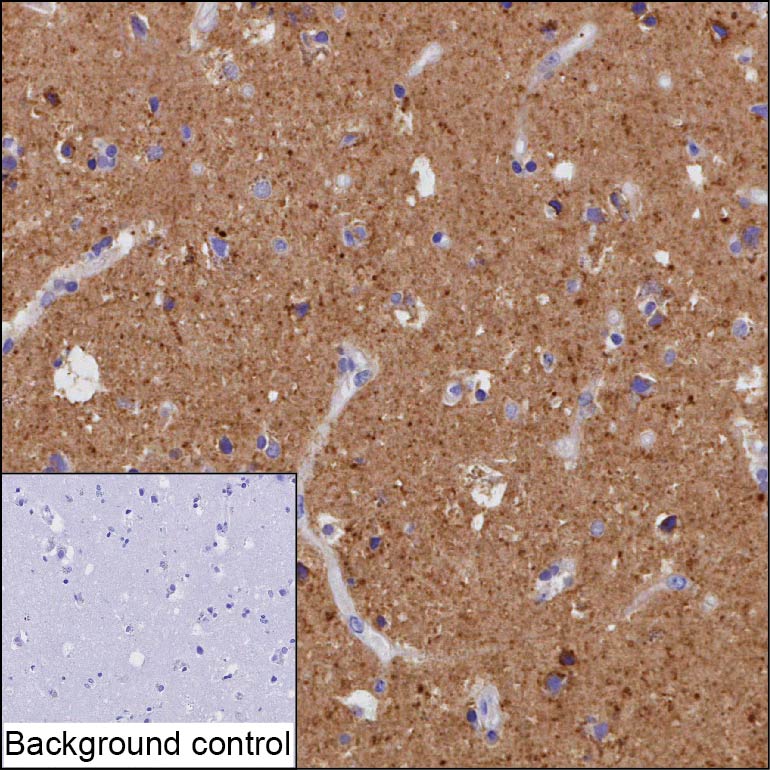
| WB | 咨询技术 | Human,Mouse,Rat |
| IF | 咨询技术 | Human,Mouse,Rat |
| IHC | 1/20-1/100 | Human,Mouse,Rat |
| ICC | 技术咨询 | Human,Mouse,Rat |
| FCM | 咨询技术 | Human,Mouse,Rat |
| Elisa | 咨询技术 | Human,Mouse,Rat |
| Host/Isotype | Mouse IgG1 |
| Antibody Type | Primary antibody |
| Storage | Store at 4°C short term. Aliquot and store at -20°C long term. Avoid freeze/thaw cycles. |
| Species Reactivity | Human |
| Immunogen | Purified recombinant fragment of human NRXN3 |
| Formulation | Purified antibody in PBS with 0.05% sodium azide |
+ +
以下是关于NRXN3抗体的3篇参考文献及其简要摘要:
1. **"Antibody characterization for the detection of NRXN3 isoforms in human tissues"**
- **作者**: Brown, A. et al. (2019)
- **摘要**: 该研究开发并验证了针对NRXN3不同剪接变体的特异性单克隆抗体,通过免疫印迹和免疫组化分析,确认了其在人脑及周围组织中的差异表达和定位。
2. **"Altered expression of neurexin-3 in autism spectrum disorder"**
- **作者**: Johnson, R. et al. (2018)
- **摘要**: 使用NRXN3特异性抗体分析自闭症患者脑组织,发现前额叶皮层中NRXN3蛋白水平显著下调,提示其突触功能异常可能与疾病病理相关。
3. **"NRXN3 variants and their association with cocaine addiction"**
- **作者**: Lee, S. et al. (2021)
- **摘要**: 通过Western blot和ELISA检测携带NRXN3基因变异个体的脑脊液样本,发现特定突变导致蛋白表达降低,抗体实验支持NRXN3在成瘾行为中的潜在作用。
这些文献涵盖了抗体开发、疾病关联及功能研究,均明确涉及NRXN3抗体的应用或验证。
The NRXN3 antibody targets the protein product of the NRXN3 (neurexin 3) gene, a member of the neurexin family of presynaptic cell adhesion molecules. Neurexins play critical roles in synapse formation, maintenance, and function by interacting with postsynaptic ligands like neuroligins. NRXN3 exists in multiple isoforms (α and β) generated by alternative splicing, which influence its binding specificity and functional diversity. It is highly expressed in the central nervous system, particularly in regions associated with reward pathways, addiction, and neurodevelopmental processes.
Research links NRXN3 to neuropsychiatric disorders, including schizophrenia, autism spectrum disorders, and substance use disorders, with genetic variations in NRXN3 associated with altered synaptic connectivity and behavioral phenotypes. NRXN3 antibodies are essential tools for studying its expression, localization, and interactions in neuronal tissues. They are used in techniques like immunohistochemistry, Western blotting, and immunofluorescence to explore its role in synaptic plasticity and disease mechanisms.
Recent studies also suggest NRXN3's involvement in regulating neurotransmitter release and its potential as a biomarker for certain neurological conditions. Commercial NRXN3 antibodies are typically validated for specificity against distinct isoforms or epitopes, aiding in functional studies and translational research. However, challenges remain in standardizing antibody performance across experimental models due to the protein's complexity and splice variants.
×